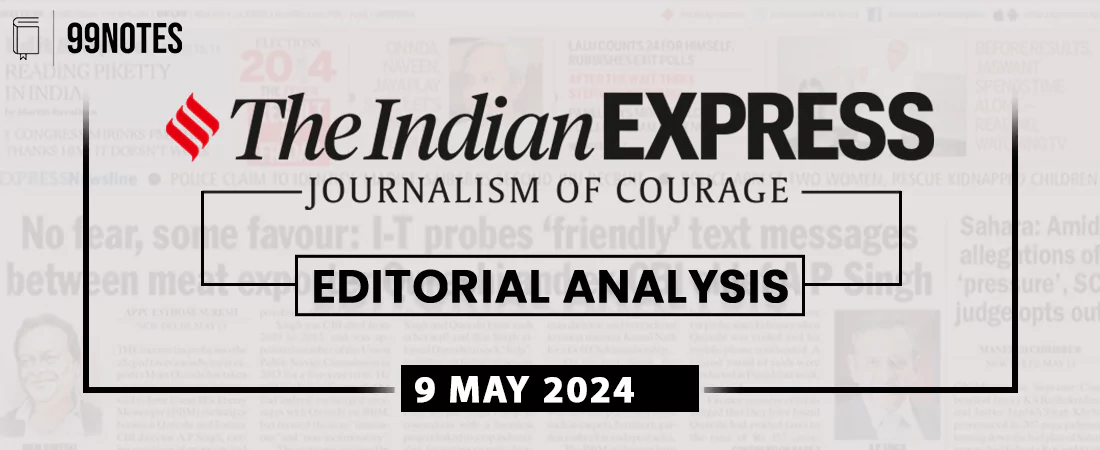9 May 2024 : Indian Express Editorial Analysis
1. From home to workplace
| Topic: GS2 – Governance – Government policies – Interventions for development in various sectors |
| Context: |
|
Expanding Labour Force Participation:
- Background: India’s overall employment rate is notably lower compared to countries like China and Bangladesh, primarily due to women’s low labour force participation (LFP) rate.
- What is ‘Labour Force Participation Rate’?
Definition: Labour force participation rate is defined as the section of working population in the age group of 16-64 in the economy currently employed or seeking employment. People who are still undergoing studies, housewives and persons above the age of 64 are not reckoned in the labour force.
- Policy Recommendation:
- Increasing women’s LFP to 50% of the labour force can significantly contribute to achieving higher GDP growth rates and a five-trillion-dollar economy by 2030.
- This can be facilitated by focusing on labour-intensive sectors like ready-made garments and footwear, where women constitute a significant portion of the workforce.
- Expanding the Production Linked Investment (PLI) scheme to include these sectors can mitigate cost disadvantages and create more job opportunities for women.
Enhancing Formal Sector Participation:
- Background: India’s transition from low- to high-productivity activity in the formal sector is slow, leading to concerns about the quality of jobs.
- Policy Recommendation:
- Addressing gender imbalances in the skilling ecosystem is crucial. While several initiatives aim to improve skilling, they often overlook gender disparities.
- Enhancing physical access, financial support, and employer matches after skill training can encourage more women to join the formal sector.
- Increasing the number of training institutes exclusively for women and providing scholarships and subsidized loans can improve women’s access to vocational training.
- Additionally, career counselling and mentorship programs can help bridge the gender gap in employment outcomes post-training.
Urban Infrastructure and Mobility:
- Background: Urbanization in India presents opportunities for women’s economic participation, but mobility constraints hinder their access to education and work opportunities.
- Policy Recommendation:
- Urban infrastructure planning should prioritize women’s mobility and safety.
- Subsidized urban care infrastructure can not only relieve women from care work but also create new job opportunities for them.
- By focusing on gender-sensitive urban planning, India can encourage more women to participate actively in the urban workforce.
Energy Transition and Domestic Work:
- Background: Women’s domestic responsibilities, particularly cooking, contribute to their time poverty and restrict their participation in the workforce.
- Policy Recommendation:
- India’s energy transition policies can incentivize households to adopt clean technology, reducing women’s time spent on domestic chores.
- Initiatives like the Pradhan Mantri Ujjwala Yojana (PMUY) have facilitated the shift towards cleaner cooking fuels, but there’s room for improvement in ensuring regular usage.
- Adopting measures like cash rebates for clean technology purchases can further accelerate this transition and create new jobs in the clean energy sector, thus alleviating women’s burden of domestic work.
Conclusion:
- Empowering women economically is integral to India’s journey towards development.
- By expanding women’s labour force participation, enhancing their formal sector participation through skilling initiatives, improving urban infrastructure and mobility, and incentivizing clean energy adoption, India can create a conducive environment for women to thrive in the workforce.
- Investing in women’s human capital is not only essential for achieving gender parity but also crucial for fostering a developed and inclusive society by 2047.
| What are the Indian Initiatives to reduce Gender Gap in Social, Economic and Political Life? |
Economic Participation and Health and Survival:
Political Reservation:
|
| PYQ: Which of the following gives ‘Global Gender Gap Index’ ranking to the countries of the world? (2017) (a) World Economic Forum (b) UN Human Rights Council (c) UN Women (d) World Health Organization Ans: (a) |
| Practice Question: How can India’s new government promote gender equality and women’s economic empowerment to accelerate the country’s development goals by 2047? (250 words/15 m) |
2. Roti, kapda, makaan, good air
| Topic: GS2 – Governance – Government policies – Interventions for development in various sectors
GS3 – Environment – Environment Pollution and Degradation |
| Context: |
|
Lack of Priority in Political Agendas:
- Background: Manifestos typically reflect the issues that resonate with voters, shaping political priorities.
- Analysis:
- Despite its significance, air quality has not emerged as a top priority for either voters or political parties.
- Limited information dissemination by local government bodies has contributed to the public’s lack of concern regarding air pollution, which could have severe consequences in the future.
Perception of Air Quality:
- Background: Some perceive poor air quality as an inevitable consequence of economic development, prioritizing economic progress over environmental concerns.
- Analysis:
- However, studies indicate substantial economic losses due to air pollution, highlighting the need for urgent action.
- Economic theories like the Kuznets curve suggest that environmental degradation initially increases with economic development but eventually improves.
- Yet, the challenge lies in determining the threshold of economic development where this improvement occurs.
Turning Air Pollution into a Political Agenda:
- Background: Air pollution must become a mainstream political issue to drive significant change.
- Analysis:
- For this to happen, it needs consistent coverage in mainstream media and public discourse.
- Generating public awareness is crucial, requiring collaboration between academia, scientific communities, and local government bodies.
- Initiatives like the National Clean Air Programme (NCAP) are commendable but require better implementation and decentralization.
Strategies for Improvement:
- Background: To address air pollution effectively, on-ground activities and public awareness are essential.
- Analysis:
- Allocating funds for pollution reduction efforts, decentralizing policies, and engaging local communities are critical steps.
- Micro-level initiatives, such as identifying pollution hotspots and creating green zones, can directly involve individuals in pollution mitigation efforts.
- Additionally, regular public awareness programs and mass movements are vital for spreading the demand for clean air across the country.
Conclusion:
- Efforts to improve air quality in India must transcend political promises and become a collective endeavor involving all stakeholders.
- By prioritizing public awareness, decentralized action, and community engagement, India can progress towards cleaner air and a sustainable future.
| What Measures should be taken to Control Air Pollution? |
|
| PYQ: What are the key features of the National Clean Air Programme (NCAP) initiated by the Government of India? (UPSC CSE (M) GS-3 2020) |
| Practice Question: How can India transition air pollution from a neglected issue to a prominent political agenda, and what strategies are essential for effective implementation of policies to combat air pollution at both macro and micro levels? (250 words/15 m) |


